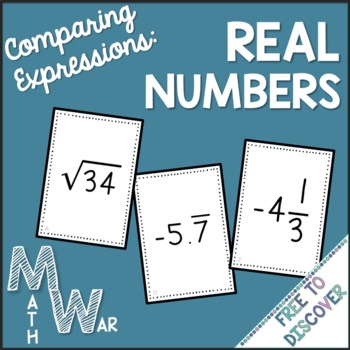Comparing Real Numbers Card Game
- Zip
Also included in
- "The lessons are so much more clearly written than the lessons in our textbook!" Teachers around the country are raving about this unique curriculum. This eighth grade math curriculum bundle contains a full differentiated curriculum and all 8th grade math activities. It consists of differentiated nPrice $297.00Original Price $556.75Save $259.75
Description
Students will practice comparing real numbers represented as radicals (square roots), repeating decimals, terminating decimals, fractions, and integers. All of the numbers are located between -6 and 6 to increase the challenge when comparing. Often times the same number will be represented in more than one way. Played just like the traditional card game, Math War is a game played in pairs or small groups with an objective of obtaining the greatest number of cards. Students turn over one card at a time and compare the value of the number on the card. Whichever student has the card with the largest value keeps all the cards. If the value is the same, students flip three cards upside down and one right side up and compare. The game is over when a student has all of the cards or the time is up.
Included in this product:
-40 cards
-Answer Key
-Teacher's Guide with CCSS, objective, materials, and procedure
-Editable Template
You may also like:
Math War: Comparing Fractions, Decimals, and Percents
Copyright Information and Terms of Use:
The purchase of this product entitles a single user to reproduce the resource for classroom use only. Discounted additional licenses can be purchased if you wish to share with other teachers. The product is for educational use only. The product may not be used for commercial purposes or resold in any form. It cannot be uploaded to the Internet, with the exception of password-protected school websites.
© Free to Discover (Amanda Nix)



